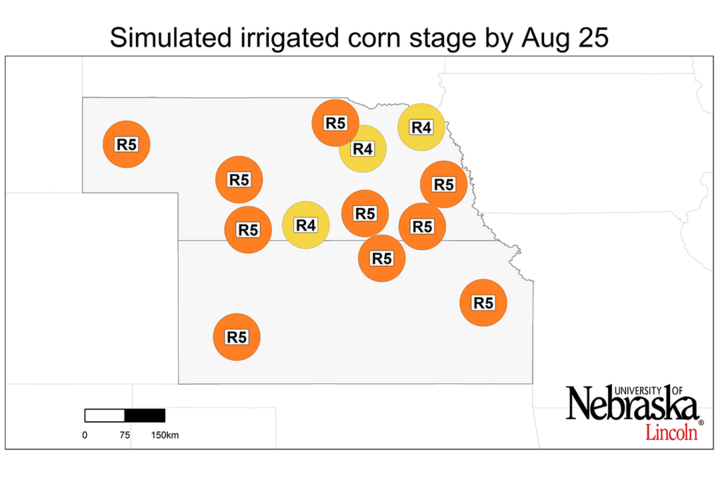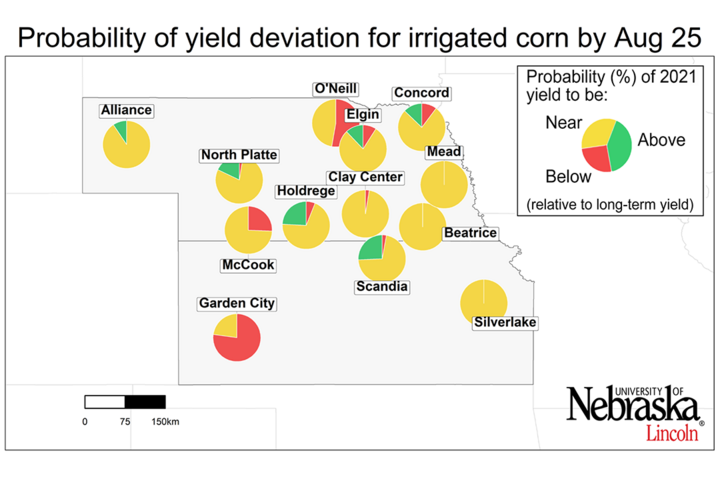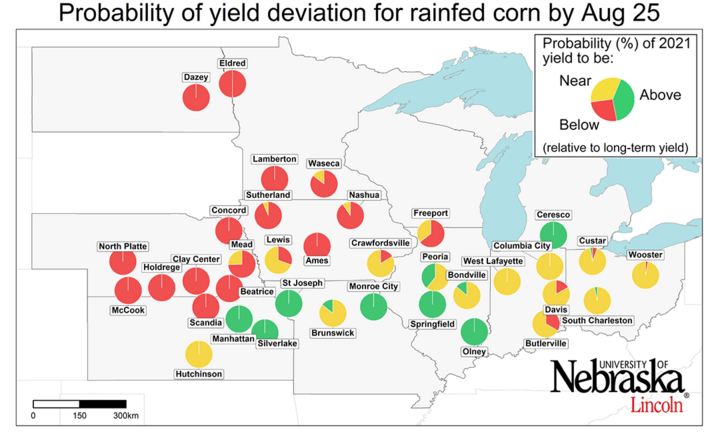This article summarizes the simulated crop stages and yield forecasts performed on Aug. 25 for 40 locations across the U.S. Corn Belt using the UNL Hybrid-Maize crop model; the data can be downloaded here. Details on the underpinning methodology to simulate phenology and forecast end-of-season yields, as well as on interpretation and uses of yield forecasts, are described in a previous article.
During the last three weeks, solar radiation tended to be near the historical average in most of the Corn Belt. Air temperature was above average across the entire region, except for MO, where sites presented near average records. In the case of rainfall, most locations exhibited near (MI, IL, KS and OH) or below-normal rainfall (most of NE, IA, MO and IN). One site (Nashua, IA) showed above average records. A summary of weather conditions during the last three weeks is shown in Figure 1.

Simulated Corn Stage Across 40 Locations
Corn has reached kernel dent stage at most locations, except for sites in the eastern fringe of the region and a few scattered sites in NE and IA where it is still in dough stage. Corn has reached physiological maturity (black layer stage) at two sites in KS (Figure 2). Most locations are similar to last year’s corn development by Aug. 25


Irrigated Corn: High Probability of Near-average Yields
The range of forecasted irrigated corn yield potential for each location, as well as the probabilities for yields above, near, or below average, are shown in Figures 3 and 4. Almost all irrigated sites (10 out of 13) exhibit a high probability (>75%, that is, three out of four chances) of near-average yield potential. Only one site (Garden City, KS) exhibits a high probability of below-average yield potential. Overall, the forecasted scenario for irrigated maize yield potential in the current season seems similar to the 2020 forecast by end of season.
Rainfed Corn: Yield Potential is Highly Variable Across Rainfed Sites
Forecasted rainfed yield potential is highly variable across rainfed sites. A high probability (>75%, that is, three out of four chances) of above average yield potential is expected in seven sites located in the southern fringe of the Corn Belt (eastern KS, MO and southern IL) and MI (Figures 3 and 4). Probability of near-average yield is high at eight sites located in the eastern part of the Corn Belt (OH, IN and eastern IL) and southern KS. Compared with our previous forecast, below-average rainfall during the past three weeks in most sites in NE and IA increased the probability of below-average yield potential in those states. Overall, 15 sites distributed in ND, MN, NE and IA have a high probability of below average yields. In the current season, the forecasted scenario for rainfed maize looks similar to the 2020 forecast for a majority of sites. However, the scenario is more pessimistic in MN, ND and parts of NE (see last year’s article).




Conclusions
In line with our previous forecasts in mid-July and early August, there is no indication that this is going to be a record — and not even an above average — year for national corn yield considering that yield is forecasted to be near or below average for the five main corn-producing states (IL, IA, NE, IN and MN). There is a high probability of near-average yields for the majority of the irrigated sites. For rainfed corn, the scenario is diverse across regions. Most sites in the eastern part of the Corn Belt have a high probability of near average yields. Above-average yield is expected at seven locations in KS, MO, MI, and IL. In contrast, 14 sites towards the northern and western fringes of the Corn Belt exhibit a high probability of below-average yields.
These forecasts do not take into consideration problems with stand emergence, hail/flooding damage, replanting situations, disease or nitrate leaching. In fields negatively affected by these constraints, actual yields will be lower than estimates provided here. It is important to keep in mind that yield forecasts are not field specific and, instead, represent an estimate of average on-farm yield for a given location and surrounding area in absence of the yield-reducing factors mentioned here. Likewise, crop stages and forecasted yields will deviate from those reported here in fields with planting dates or hybrid maturities that differ markedly from those used as the basis for these forecasts. We will follow up with the final forecasted yield and analysis of the 2021 crop season on Wednesday, Sept. 15.
